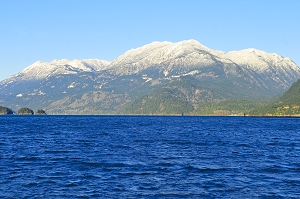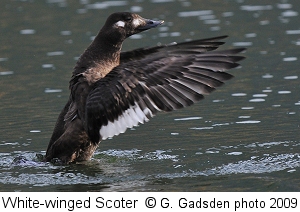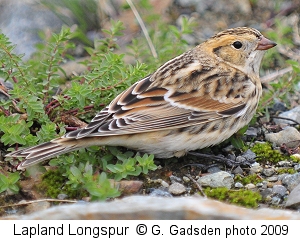HARRISON LAKE SITE GUIDE: Part 1 - Village Waterfront
Text by K.R. Jones, Maps by G. Gadsden, Photos by Fraser Valley Birding Members
Note: The Village is surrounded by fairly close mountains and the sun doesn't hit until later in the morning and it disappears quicker in the evening. Most birds are seen after the sun hits the Village, and too early a start just puts the birder in the chilly midst of a bunch of dog walkers.
INTRO
Harrison is the largest lake in the Southern  Cascade Mountains at 60 kms long and 9 kms at its widest and an overall area 250 km2 . With a few different hot springs along the lake, the best-known are at the south end, in the Village of Harrison Hot Springs. These springs have long been a healing place for people, and have been commercially developed for over 100 years. Cascade Mountains at 60 kms long and 9 kms at its widest and an overall area 250 km2 . With a few different hot springs along the lake, the best-known are at the south end, in the Village of Harrison Hot Springs. These springs have long been a healing place for people, and have been commercially developed for over 100 years.
Orientation
Exit Highway #1 at Bridal Falls, cross the Agassiz/Rosedale Bridge and proceed through Agassiz to Harrison Hot Springs. The main road into the village is the #9 Highway, but it is labeled Hot Springs Road. It enters the village and meets The Esplanade at a T intersection at the waterfront in front of the community Plaza. It confuses a lot of delivery people, governments, insurers etc., but the road running along the beach is not a road, street or avenue; it is The Esplanade, meaning a road with buildings on one side and beach on the other. The Esplanade is one-way for vehicles with 2 branches that start at the T intersection. The longer branch heads East to the Memorial Hall, past the condos and to the Boat Launch, while the shorter 1 block branch heads West to the Harrison Resort & Spa. You circle back to Hot Springs Road by going one block back from the beach to Lillooet Ave. The East end of Lillooet Ave. becomes Rockwell Drive as it turns at Bear Mountain and heads North to Sasquatch Park. The Village officially ends just before the Rock Breakwater and the District of Kent takes over.
Birding
With a strong North/South orientation, the lake is a natural migration corridor for birds. Situated at the southern end of this corridor is the Village waterfront, the most easily accessible and productive birding in the area. Spring and fall migration are peak times, but winter months yield ducks, geese, grebes, loons, crows, ravens and jays as well as a few interesting songbirds like warblers, buntings and rosy-finches. During summer months, parking is at a premium and the beach crowds chase off most nature, but Brewer's blackbirds, house sparrows, northwestern crows and a few California gulls work the beach. A great blue heron or two is always in some quiet corner. Glaucous-winged gulls are the most common of course, but during different seasons California, ring-billed, mew, Bonaparte's, herring and Thayer's are present with a few Caspian terns, the occasional common tern and, in 2010, a rare arctic tern. Shorebird sightings have been increasing lately, particularly around the Lagoon area.
LOCATIONS .jpg)
Traffic flow and parking in the village means the Lagoon is central and the usual starting point for birding. Fall, winter and spring, the Lagoon is probably the most productive as well, but this means to cover the whole Waterfront we must go east as well as west. For the sake of clarity we will work our way from the northwest along the waterfront to the northeast. To view a map of these locations, click on the map. Use your veiwer to zoom in to view the text better.
1. Whipperwill Point
To the Northwest of the village is Whipporwill  Point aka Sandy Point, accessible from a trail to the west of the Harrison Resort & Spa. It is a bit of a hike and involves some climbing, so is usually a rare hike bird wise but affords views of the East side of the lake between the head of the Harrison River and Echo Island. This seems to be a hot zone for scoters, scaups, buffleheads, goldeneyes, grebes and loons. Point aka Sandy Point, accessible from a trail to the west of the Harrison Resort & Spa. It is a bit of a hike and involves some climbing, so is usually a rare hike bird wise but affords views of the East side of the lake between the head of the Harrison River and Echo Island. This seems to be a hot zone for scoters, scaups, buffleheads, goldeneyes, grebes and loons.
2. Hot Springs Source
The source of the hot springs is surrounded by vaguely classical looking structure that keep people from getting burned. Some leakage happens around the site and a lukewarm soak is sometimes possible. It is an easy 5 minute walk to the West of the Resort. This area allows views of birds on the lake and a few along the wooded mountainside and trail.
3. Floodgate
At the western edge of the Resort, the Miami River flows into the lake and is controlled by a floodgate. This area attracts ducks and Canada geese in particular.
4. Float-plane Dock
On the eastern edge of the Resort is the public Floatplane Dock. A larger dock complex for renting watercraft is just to the west, on Resort property. The Float-plane Dock allows good views of the lake from the end of the dock. The dock itself attracts gulls and shorebirds.
5. Plaza
At the end of Hot Springs Road, the Plaza functions as the centre of the beach and the foot-traffic distribution hub for the Village. There are a few shrubs and trees scattered about edges that attract birds including a Say's Phoebe in 2010 and a Townsend's Solitaire in 2009.
6. Lagoon
The Lagoon was created in the 1960s with minor facelifts over the years. Most recently, native shrubs and trees have been planted on the outer arm in hopes of providing a windbreak for the sand with the added benefit of providing a bit of cover and food for those tired migrant birds coming down the lake. The outer arm is popular with snow buntings, savannah sparrows, lapland longspurs and horned larks as well as providing a good place to scope the lake. The inner arm is a grass strip beside a raised sidewalk that runs along The Esplanade. This area is popular with northwestern crows, common ravens, blackbirds, sparrows, western meadowlarks and Canada, cackling and the occasional greater white-fronted goose. The Lagoon itself attracts a wide range of ducks including rarer species like ruddy ducks, redheads, canvasbacks as well as mallards, lesser and greater scaups, mergansers, wigeons, buffleheads, northern pintails, northern shovelers and teal. Shorebirds such as least and spotted sandpipers, greater yellowlegs and killdeers are common, with occasional sightings of Baird's sandpiper, sanderlings, dunlin, long-billed dowitchers on the increase. An American avocet and a stilt sandpiper were both photographed in 2010. shrubs and trees have been planted on the outer arm in hopes of providing a windbreak for the sand with the added benefit of providing a bit of cover and food for those tired migrant birds coming down the lake. The outer arm is popular with snow buntings, savannah sparrows, lapland longspurs and horned larks as well as providing a good place to scope the lake. The inner arm is a grass strip beside a raised sidewalk that runs along The Esplanade. This area is popular with northwestern crows, common ravens, blackbirds, sparrows, western meadowlarks and Canada, cackling and the occasional greater white-fronted goose. The Lagoon itself attracts a wide range of ducks including rarer species like ruddy ducks, redheads, canvasbacks as well as mallards, lesser and greater scaups, mergansers, wigeons, buffleheads, northern pintails, northern shovelers and teal. Shorebirds such as least and spotted sandpipers, greater yellowlegs and killdeers are common, with occasional sightings of Baird's sandpiper, sanderlings, dunlin, long-billed dowitchers on the increase. An American avocet and a stilt sandpiper were both photographed in 2010.
7. Boat Launch
East of Lagoon, the boat launch gravel parking  lot is a good spot for sparrows and other songbirds. In 2010, record numbers of vesper sparrows were seen on the gravel during migration. During the fall and winter, up to four gray-crowned rosy-finches seemed to take up residence. lot is a good spot for sparrows and other songbirds. In 2010, record numbers of vesper sparrows were seen on the gravel during migration. During the fall and winter, up to four gray-crowned rosy-finches seemed to take up residence.
8. Rendall Park
East of the boat launch is Rendall Park with good views of a small bay and the marinas and a path through mature Maples. This is a good area for American dipper, great-blue heron, gull, sparrows and woodpeckers.
9. Art Gallery
Heading north is the Ranger Station Art Gallery. The front yard of the Gallery has good views of Bear Mountain, and is a great place to see warblers, nuthatches, chickadees, brown creepers and kinglets. The backyard is a great place to set up a scope for views of the lake.
10. Marinas
North of the Gallery, the Harrison Yacht Club and two private marinas have wooden docks behind a log breakwater which runs north/south. The logs are popular with gulls and harbour seals often sit on the logs. Waterbirds are often swimming amongst the boats. And a northern flicker has a nest in one of the pilings.
11. Breakwater 
To the far northeast of the village on Rockwell Drive is a large rock breakwater running east/west. It was often submerged during high water in years past, but this winter it was renovated and raised substantially. There is a small gravel parking lot at the base of the breakwater, often used by windsurfers as a launch point. This area affords good looks at the lake, marinas and Echo Island. The rocks attract gulls and an occasional tern. The shoreline attracts sparrows and American pipits, close views of Bear Mountain can be had from the parking lot.
LINKS
For more on Harrison birding see http://mypage.uniserve.ca/~djperrin/
For more area information check out Tourism Harrison's website at http://www.tourismharrison.com/
or the local Chamber of Commerce website at http://harrison.ca/

|